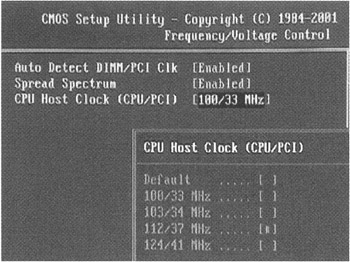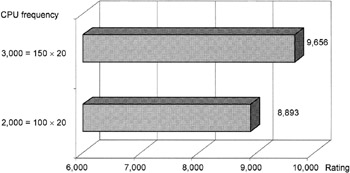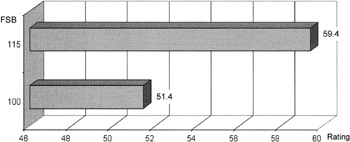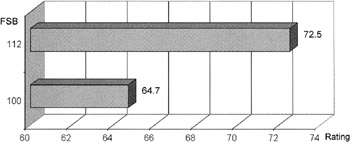Chapter 8: Approaches to Processor Overclocking
Chapter 8: Approaches to Processor Overclocking
Processor overclocking usually is achieved by increasing the FSB frequency or by changing the multiplier. However, the best computer performance can be achieved by using a complex approach that accounts for component parameters and characteristics specific to the chosen modes.
Processors have significant technological reserve ensured by manufacturers. This reserve allows the CPU performance to be improved by overclocking, which can be achieved by raising the FSB frequency or other methods.
Increasing the FSB Frequency
When you consider using overclocked modes, remember that practically all processors have a fixed value for the multiplier — the coefficient that relates the core frequency to the external frequency. This is especially true for Intel products, the majority of the processor market. The list of Intel processors includes Pentium II, Pentium III (Katmai, Coppermine, and Tualatin), Pentium 4 (Willamette and Northwood), and Celeron. There is no indication that this situation will change in the near future. This means that increasing the FSB frequency remains the main method of overclocking.
The early IBM XT computers equipped with an Intel 8088 processor, intended to operate at 4.7 MHz, could be overclocked to 12 MHz. Numerous processors of Intel's 386 family and their clones were intended to run at 33 MHz; however, they usually were used at 40 MHz. These capabilities often were provided and ensured by manufacturers. Although such facts were rarely promoted, most computers of that time had a Normal/Turbo button on the front panel for switching the system to the overclocked mode.
Hardware implementation of the Turbo mode ensured considerable performance growth while retaining the required level of stability. Although these modes didn't correspond to specifications of the computer components, such architecture was standard: Manufacturers of such systems offered warranties for their products.
Since the times of 386 computers, CPU architecture has become more complicated. Clock frequencies have multiplied more than 100 times. The operating speed of these computer components has grown even more significantly. However, establishing forced operating modes by increasing the CPU clock frequency remains the most popular method of implementing potential capabilities of contemporary processors and obtaining maximal performance.
Increasing the CPU clock frequency, as well as overclocking other components and subsystems, is achieved by raising the FSB clock frequency. Depending on the type of motherboard, the required value of the FSB clock frequency is chosen by setting Dual In-line Package (DIP) switches or parameters in BIOS Setup.

Figure 8.1: Setting the FSB frequency using DIP switches

Figure 8.2: Setting the FSB frequency using BIOS Setup
The range of FSB frequencies — and, consequently, the theoretical growth of computer performance — is determined by the motherboard. This depends on the elements used in the motherboard's construction, its design, the quality of its manufacturing, the BIOS software code, the functional capabilities, and so on.
The performance of Celeron (Northwood) overclocked via increased FSB frequency is shown in Table 8.1 and in Figs. 8.3 and 8.4.

Figure 8.3: Overclocking Celeron (Northwood) (tested using SYSmark 2002)

Figure 8.4: Overclocking Celeron (Northwood) (tested using 3DMark2001)
|
CPU frequency (MHz) = FSB frequency × multiplier |
SYSmark 2002 rating (Internet content creation) |
3DMark2001 rating |
|---|---|---|
|
2,000 = 100 × 20 |
246 |
8,893 |
|
3,000 = 150 × 20 |
279 |
9,656 |
Like the Intel processors, AMD products such as Duron, Athlon (Thunder-bird), and Athlon XP (Palomino, Thoroughbred, and Barton), usually have fixed multipliers, although in some cases, the multiplier can be unlocked and changed.
As a consequence of the Socket A form factor, for which Athlon is designed and which doesn't allow operations with resistors, frequency multipliers can be changed using special hardware and software of the motherboard.
Features and secrets of implementing the potential functional capabilities of these hardware and software tools, which allow the correction of frequency multipliers of AMD's Socket A processors, will be analyzed in the next section of this chapter. Here, consider a traditional method based on increasing the FSB frequency, also used on Intel processors.
This method, when used on Duron and Athlon, is achieved at the expense of increasing the external frequency (i.e., the FSB EV6 bus frequency).
The performance of Duron and Athlon achieved by increasing the FSB EV6 bus frequency is shown in Tables 8.2 and 8.3 and in Figs. 8.5 and 8.6.

Figure 8.5: Overclocking Duron by increasing the bus frequency (tested using CPUmark 99)

Figure 8.6: Overclocking Athlon (Thunderbird) by increasing the bus frequency (tested using CPUmark 99)
|
CPU frequency (MHz) = FSB frequency × multiplier |
CPUmark 99 rating |
FPU WinMark rating |
|---|---|---|
|
600 = 100 × 6 |
51.4 |
3,260 |
|
690 = 115 × 6 |
59.4 |
3,760 |
|
CPU frequency = FSB frequency × multiplier |
CPUmark 99 rating |
FPU WinMark rating |
|---|---|---|
|
700 = 100 × 7 |
64.7 |
3,810 |
|
784 = 112 × 7 |
72.5 |
4,270 |
Detailed information on the overclocking of Duron, Athlon, and Athlon XP will be given in Chapter 18.
Despite the insignificant performance growth of systems based on the VIA Apollo KT133 chipset from Via Technologies, obtained by processor overclocking at the expense of increasing clock frequencies of the FSB EV6 bus, this method has become popular. After the release of more advanced chipsets (such as Apollo KT133A, KT266A, KT333, and KT400) intended for operation at a wider range of FSB EV6 clock frequencies (including 133 MHz and 166 MHz), this overclocking method became even more popular. Complemented by the capability of changing the values of the frequency multipliers for Duron, Athlon, and Athlon XP (provided by motherboards, rather than the processors), this method allowed impressive results. The true value of these can be estimated only after considering overclocking methods that involve changing the multiplier.






